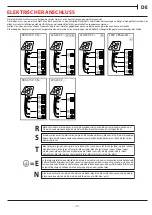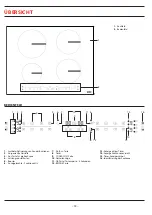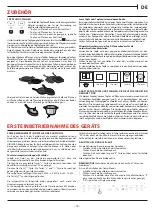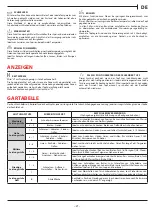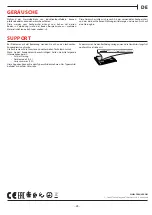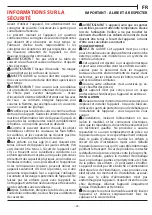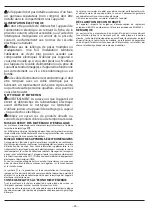
BOILING
This function allows you to bring water to the boil and keep it boiling, with
lower energy consumption.
About 2 litres of water (preferably at room temperature) should be placed
in the pan.
In all cases, users are advised to closely monitor the boiling water and
check the amount of water remaining regularly.
If the pots are big and the water quantity is higher than 2 litres, we
recommend using a lid to optimize boiling time.
INDICATORS
RESIDUAL HEAT
If “H“ appears on the display, this means that the cooking zone is hot.
The indicator lights up even if the zone has not been activated but has
been heated due to the adjacent zones' use or because a hot pot has been
placed on it.
When the cooking zone has cooled down, the “H“ disappears.
POT INCORRECTLY POSITIONED OR MISSING
This symbol appears if the pot is not suitable for induction cooking, is not
positioned correctly, or is not of an appropriate size for the cooking zone
selected. If no pot is detected within 30 seconds of making the selection,
the cooking zone switches off.
COOKING TABLE
POWER LEVEL
TYPE OF COOKING
LEVEL USE
(indicating cooking experience and habits)
Maximum
power
P
Fast heating/Booster
Ideal for rapidly increasing the temperature of food to fast boiling in the case of
water or rapidly heating cooking liquids.
8 − 9
Frying − boiling
Ideal for browning, starting to cook, frying deep frozen products, fast boiling.
High power
7 − 8
Browning − sautéing − boiling −
grilling
Ideal for sautéing, maintaining a lively boil, cooking and grilling (for a short
period of time, 5-10 minutes).
6 − 7
Browning − cooking − stewing −
sautéing − grilling
Ideal for sautéing, maintaining a light boil, cooking and grilling (for a medium
period of time, 10-20 minutes), preheating accessories.
Medium power
4 − 5
Cooking − stewing − sautéing −
grilling
Ideal for stewing, maintaining a gentle boil, cooking (for a long period of time).
Creaming pasta.
3 − 4
Cooking − simmering − thickening
− creaming
Ideal for long-cooking recipes (rice, sauces, roasts, fish) with liquids (e.g., water,
wines, broth, milk), creaming pasta.
2 − 3
Ideal for long-cooking recipes (less than a litre in volume: rice, sauces, roasts, fish)
with liquids (e.g., water, wines, broth, milk).
Low power
1 − 2
Melting − defrosting − keeping
food warm − creaming
Ideal for softening butter, gently melting chocolate, thawing small products, and
keeping just-cooked food warm (e.g., sauces, soups, minestrone).
1
Ideal for keeping just-cooked food warm, for creaming risottos and keeping
serving dishes warm (with induction-suitable accessory).
Zero power
0
Support surface
Hob in stand-by or off mode (possible end-of-cooking residual heat, indicated
by an “H“).
The cooking table offers an example of the cooking type for each power level. The actual delivered power of each power level depends on the cooking
zone dimension.
CLEANING AND MAINTENANCE
!
WARNING
• Do not use steam cleaning equipment.
• Before cleaning, make sure the cooking zones are switched off and that the residual heat indicator (“H“) is not displayed.
Important:
• Do not use abrasive sponges or scouring pads as they may damage
the glass.
• After each use, clean the hob (when it is cool) to remove any deposits
and stains from food residue.
• A surface that is not kept suitably clean may reduce the sensitivity of
control panel buttons.
• Use a scraper only if residues are stuck to the hob. Follow the scraper
manufacturer's instructions to avoid scratching the glass.
• Sugar or foods with a high sugar content can damage the hob and
must be immediately removed.
• Salt, sugar, and sand could scratch the glass surface.
• Use a soft cloth, absorbent kitchen paper, or a special hob cleaner
(follow the Manufacturer’s instructions).
• Spills of liquid in the cooking zones can cause the pots to move or vibrate.
• After cleaning the hob, dry thoroughly.
EN
– 11 –

















